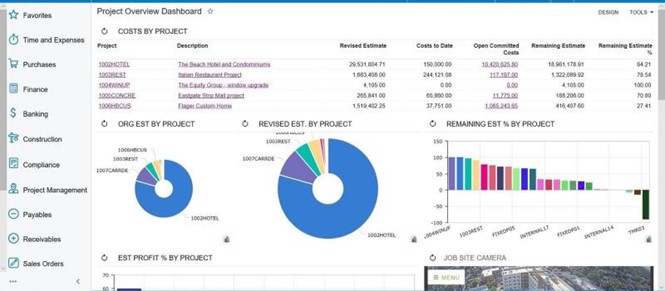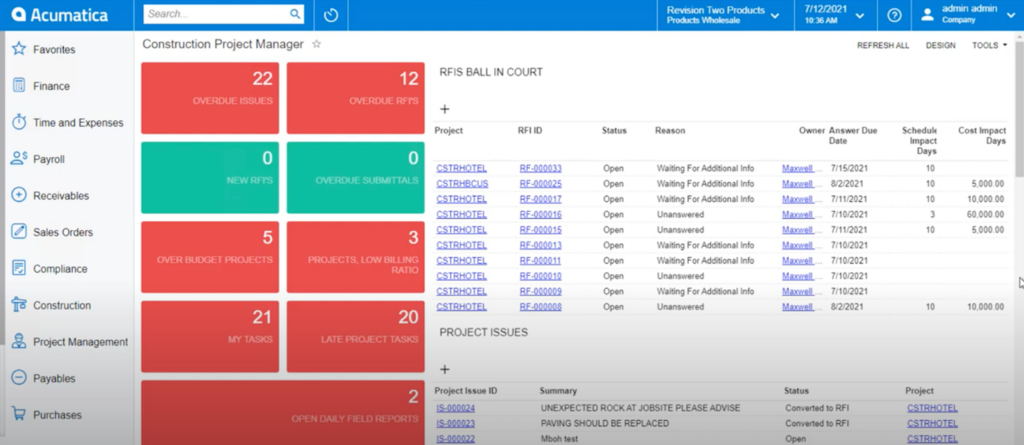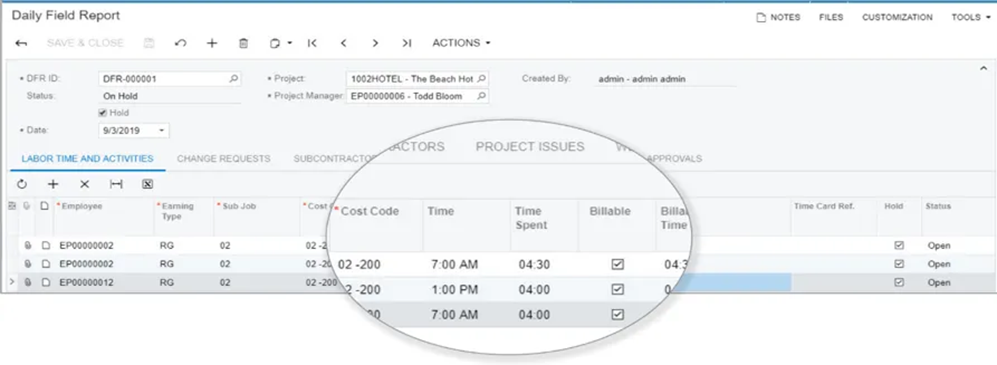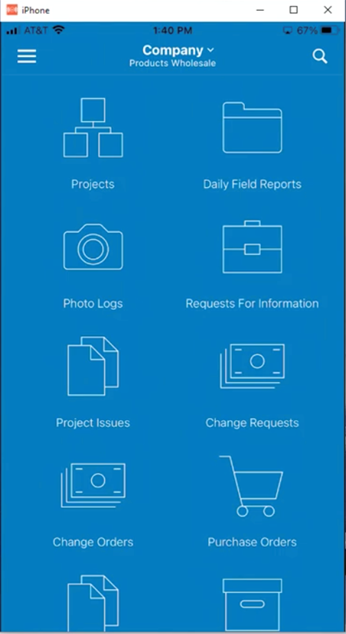Modern contractors recognize that effective project management is the key to success. Acumatica Construction Edition offers a robust suite of features designed to streamline project management and boost efficiency. Let’s look at some of its functionality that can streamline your project management workflow.
Overview of Project Management Dashboard and Settings
Acumatica Construction Edition provides you with a centralized hub to efficiently manage all aspects of your construction projects.
Customizable Project Management Dashboard
- Widgets Galore: The Project Management Dashboard is highly customizable, offering a wide range of widgets. These can display various types of information, including charts, tables, graphs, key performance indicators (KPIs), trend cards, and more. This flexibility allows users to tailor the dashboard to their needs.
- Embedded Web Pages: Acumatica Construction Edition goes beyond standard widgets. It allows users to embed live web pages directly into the dashboard. This means you can integrate job site cameras or other external web-based tools right into your project management dashboard for real-time project monitoring.
- At-a-Glance Insights: Dashboards provides a high-level view of all construction projects in the system, giving users a quick overview of project statuses, key metrics, and other vital information. This visual representation simplifies project tracking and decision-making.

Project Management Settings
- Preferences for Drawing Logs and Photo Logs: Acumatica Construction Edition allows users to configure specific preferences related to drawing logs and photo logs. This includes settings for how these logs are organized, displayed, and utilized within the system.
- Project Management Classes: Users can add custom classes to the system, tailoring it to their unique project management processes. These classes help categorize and organize project-related data, making it easier to manage and analyze.
- General Settings: Users can access and modify general project management settings, such as due date calculations, project issue settings, RFI (Request for Information) settings, and Daily Field Report settings. These settings ensure that the construction management process aligns with the organization’s specific needs and workflows.
Requests for Information (RFIs)
RFIs are designed to streamline communication, facilitate collaboration, and ensure that all project-related inquiries and clarifications are documented and addressed effectively.

Efficient Management of RFIs
- Centralized RFI Dashboard: Acumatica Construction Edition provides a dedicated RFI dashboard where users can manage all RFIs associated with their construction projects.
- Status Tracking: The RFI dashboard displays the current status of each RFI, making it easy to identify which RFIs are open, closed, or pending, which ensures that RFIs are addressed promptly and transparently.
- Detailed Information: Users can access comprehensive information about each RFI directly from the dashboard. This includes details such as the RFI’s project association, due date, and any attached documents.
Creation and Collaboration
- Creating RFIs: Acumatica Construction Edition allows users to create RFIs easily within the system. RFIs can originate from various stakeholders, such as architects, engineers, superintendents, or project managers.
- Communication and Collaboration: It promotes collaboration by enabling users to communicate effectively within the system. Conversations, updates, and responses related to RFIs can be documented and tracked, ensuring that all relevant parties are informed and engaged in the resolution process.
- Scheduled Reminders: Acumatica can send scheduled reminders about pending RFIs, helping teams stay on top of their responsibilities and ensuring that RFIs do not fall through the cracks.
Integration with Change Orders
- Seamless Workflow: If an RFI leads to a change in project specifications or requirements, it can be converted into a change request, streamlining the process for formalizing changes.
- Cost and Schedule Impact: Users can assess the cost and schedule impact of an RFI, ensuring that any adjustments to the project plan are carefully evaluated and documented.
Product Issues and Change Requests
These features are designed to help construction professionals address and manage issues that arise during construction projects and facilitate the efficient handling of change requests.
Product Issues
- Detailed Issue Tracking: Users can create product issues within the system, documenting details such as its project association, priority level, and other relevant information.
- Status Monitoring: The system provides real-time status monitoring for product issues, allowing users to see which issues are open, resolved, or in progress. This visibility ensures that issues are addressed promptly.
- Document Attachments: Users can attach documents or images related to the product issue, providing additional context to facilitate resolution.
Change Requests
- Detailed Information: Users can create detailed change requests, specifying the nature of the change, its impact on the project’s cost, schedule, and design, along with any supporting documents or drawings.
- Status Tracking: Like product issues, change requests can be tracked based on their status. Users can see which change requests are awaiting approval, in progress, or completed.
- Integration with Project Issues: Change requests can be linked to specific project or product issues. This allows users to trace the origin of a change request and understand the context in which it was initiated.
- Cost Tracking: Acumatica Construction Edition enables users to assess the cost and schedule impact of both product issues and change requests. This assessment helps project stakeholders make informed decisions regarding the approval and prioritization of changes.
- Change Order Creation: If a change request is approved, it can be converted into a formal change order. This streamlined process ensures that changes are properly documented and incorporated into the project plan.
Drawing Logs
Keep track of all project drawings, keeping them organized and easily accessible for the team members who need them with these powerful features.

Detailed Information on All Drawings
- Project Association: Each drawing is associated with a specific construction project, making it easy to locate and retrieve drawings relevant to a particular job.
- Discipline-Based Categorization: Acumatica Construction Edition provides the flexibility to categorize drawings by discipline, such as architectural, civil, electrical, mechanical, and more. Users can customize these disciplines to align with the specific needs of their projects.
- Description: For each drawing, users can provide a detailed description that includes information about its purpose, content, and any relevant notes. This description helps project stakeholders understand the drawing’s context and purpose.
Powerful Document Management Features
- Organization and Storage: Drawing Logs serve as a central repository for all project-related drawings and plans. Users can organize and store drawings in a structured manner, ensuring that everyone on the project team has easy access to the necessary documents.
- Revision Tracking: The system allows users to track revisions to drawings. This is crucial in construction, as plans often undergo updates and modifications throughout a project’s lifecycle. Users can easily identify and access the most current version of a drawing.
- Ownership and Responsibility: Drawing Logs include information about who is responsible for each drawing. This ensures that there is clarity regarding who to contact for questions or concerns related to a specific drawing.
- Hyperlinking: Hyperlinks within the Drawing Logs allow users to quickly access the actual drawing files or related documents. This eliminates the need to search for drawings in external file systems, saving time and improving efficiency.
Daily Field Reports (DFRs)
Don’t miss a single activity on the job site! With DFRs, your site foremen can ensure that everything is documented, and the project moves ahead at a good pace.

Accurate Job Site Reporting
- Labor Time and Activities: DFRs allow users to track labor hours, activities, and tasks performed by on-site personnel. This includes recording employee names, hours worked, tasks completed, and cost codes associated with the work.
- Subcontractor Tracking: DFRs allow for the recording of subcontractor activities, including the names of subcontractors, the number of workers present, and the duration of their work on-site.
- Project Issues: Any project issues that arise during the day can be documented in DFRs. This may include incidents, challenges, or problems encountered and their potential impact on the project.
- Photo Logs Integration: Users can attach photo logs to DFRs, providing visual documentation of the site’s condition and progress on a given day.
- Weather Tracking: DFRs include a weather section where users can record weather conditions such as temperature, precipitation, wind speed, and any weather-related impacts on the project.
- Visitor Logs: DFRs allow users to track and log visitors to the construction site, noting their purpose for visiting and the duration of their stay.
Consistent Workflow
- Creation of New DFRs: Users can create new DFRs for each day on the construction site. DFRs typically follow a standardized template, ensuring consistency in reporting.
- Updating Status: DFRs may have different statuses, such as “On Hold,” “Approved,” or “Closed.” These statuses indicate the progress of the daily report and whether it has been reviewed and approved.
- Attachment of Documents: Users can attach documents, photos, or additional notes to DFRs to provide further context or evidence of daily activities.
- Export and Communication: DFRs can be exported to different formats, including PDF and Excel, for sharing and distribution to project stakeholders. They can also be emailed directly from the system.
Photo Logs
Photo logs serve as a visual record of a construction project’s progress, changes, and important events. They capture critical details that may not be easily conveyed through text alone. Keep a visual timeline, document issues, reduce site visits through remote monitoring, and make solid decisions based on visible site conditions.
Key Features
- Image Capturing: Users can take and upload photos directly into the system from their mobile devices or cameras. These images can be tagged and organized within photo logs.
- Photo Organization: Photo logs allow for the categorization and organization of photos based on project phases, specific tasks, or dates. This makes it easy to locate and reference images when needed.
- Annotations and Descriptions: Users can add annotations, descriptions, and comments to each photo, providing context and explanations for the captured images.
- Linking to Other Project Elements: Photo logs can be linked to various project management components, such as daily field reports, RFIs, project issues, and drawing logs. This linkage ensures that photos are associated with relevant project documentation.
- Main Photo Selection: Within each photo log, users can select a main photo to serve as a thumbnail or preview for quick reference. This is particularly useful when browsing a list of photo logs.
Powerful Project Management
Acumatica Construction Edition is a powerful tool that enhances project management, streamlines communication, and simplifies documentation in the construction industry. By leveraging its comprehensive features, construction professionals can improve project visibility, efficiency, and ultimately, project success.
Do you want to put these powerful project management tools to work in your construction business?
Contact us today to find out how Acumatica Construction Edition can enhance your workflow and open the way to greater efficiency and higher revenues.



